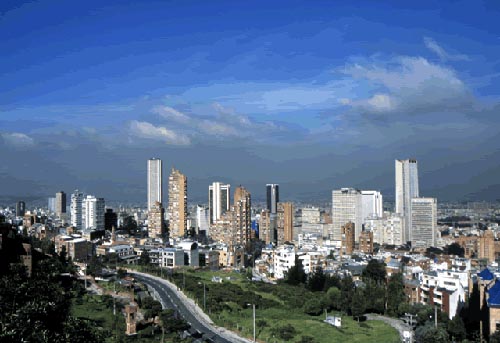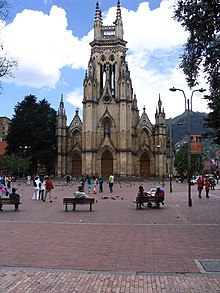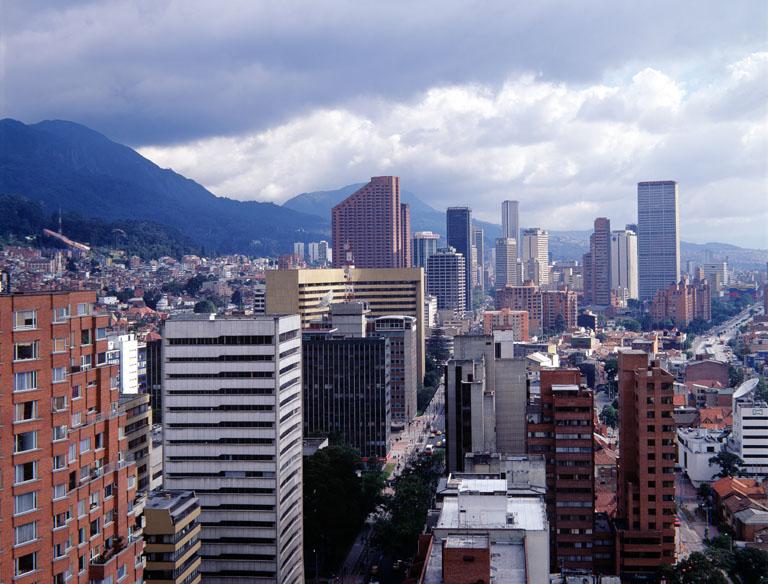 Nestled high in the Andes at 2620 m. (8646 ft), Santafé de Bogotá is a city of contrasts. It's a city of highrise buildings standing next to colonial churches; a city of universities, theaters and shantytowns. It is a mixture of influences, Spanish and English and Indian; a city of great wealth and material well being and abject poverty. It is a city of wild traffic and calm oases reflecting a bygone day. It is a modern city with futuristic architecture, graffiti and congestion; restaurants, bookstores and street vendors peddling emeralds, thieves, beggars, street people and drug dealers wrapped around the inner core of the old city.
Nestled high in the Andes at 2620 m. (8646 ft), Santafé de Bogotá is a city of contrasts. It's a city of highrise buildings standing next to colonial churches; a city of universities, theaters and shantytowns. It is a mixture of influences, Spanish and English and Indian; a city of great wealth and material well being and abject poverty. It is a city of wild traffic and calm oases reflecting a bygone day. It is a modern city with futuristic architecture, graffiti and congestion; restaurants, bookstores and street vendors peddling emeralds, thieves, beggars, street people and drug dealers wrapped around the inner core of the old city.

Santa Fé de Bogotá was founded in 1538. The name was shortened to Bogotá after independence from Spain in 1824 and was called that until recently when the original name was reinstated as Santafé de Bogotá. Until the middle of the 1900's, the city was quite provincial, the bureaucratic home of government and intellectual pursuits. The main industries were breweries, woolen textiles, and candlemaking. The residents or Bogotanos were viewed by the rest of the country as taciturn, cold and aloof. The Bogotanossaw themselves as intellectually superior to their countrymen. Despite these perceptions, the city has grown to be today an industrial and commercial center and the main offices of most coffee producing and exporting firms and flower growers.

In addition to being the capital, Bogotá is Colombia's largest economic center. Most companies in Colombia have their headquarters in Bogotá, as it is home to most foreign companies doing business in Colombia as well as Colombia's main stock market. The emerald trade is a huge business in Bogotá. In downtown Bogotá, millions of dollars in domestically produced rough and cut emeralds are bought and sold daily.
Bogotá is divided into zones, each with its own characteristics:

Zona 1 Norte. This is the most modern upscale zone. The highest income bracket neighborhoods, important commercial centers, the best restaurants, shopping centers, and nightlife are in the zona rosa.
Zona 2 Noroccidente. The city is growing out in this direction.

Zona 3 Occidente. This western sector contains industrial areas, parks, the National University and El Dorado Airport.
Zona 4 Sur. The industrial zones and large labor barrios are located in the south.
Zona 5 Centro. The central sector is the city's chief and most important commercial, cultural, governmental and financial zone.
Zona 6 Surrounding areas.
Zona 7 Other cities.

Most of the places of interest to visitors are in the central and northern zones. The city expanded from the colonial center, thus most of the great churches are here. To the east of the city, the mountains provide a constant backdrop. The most famous peak is the Cerro de Montserrat at 3030 m. (10,000 ft) and a favorite with Bogoteños who go there for the spectacular view, the park, the bull ring, restaurants and the famous religious site. The church here with the statue of the Señor Caído Fallen Christ, is claimed to be a place of miracles.  The top is accessible by climbing hundreds of stairs (not recommended,) by the cable car which runs from 9AM to 11PM daily or by the funicular which runs only on Sunday between 5:30AM and 6PM.
The top is accessible by climbing hundreds of stairs (not recommended,) by the cable car which runs from 9AM to 11PM daily or by the funicular which runs only on Sunday between 5:30AM and 6PM.
 The top is accessible by climbing hundreds of stairs (not recommended,) by the cable car which runs from 9AM to 11PM daily or by the funicular which runs only on Sunday between 5:30AM and 6PM.
The top is accessible by climbing hundreds of stairs (not recommended,) by the cable car which runs from 9AM to 11PM daily or by the funicular which runs only on Sunday between 5:30AM and 6PM.Check flights from your area. From this page, you can also browse hotels, rental cars, and special deals.
Getting around in the city is simplified by the naming convention of the streets. Most of the older streets are named carreras running north - south or calles running east - west and are numbered. The newer streets may be avenidas circularesortransversales. Bus transportation is excellent. Large busses, called bus, smaller busses called busetas and buseta, smaller buses and the microbus or colectivo van size, travel the city streets, while the Transmilenio modern articulated buses operates now on selected main streets, but is expected to cover the entire city in the next decade.

In addition to taxis, bicycles abound in the city. The ciclorrutas is an extensive bike path serving all points of the compass.

No comments:
Post a Comment